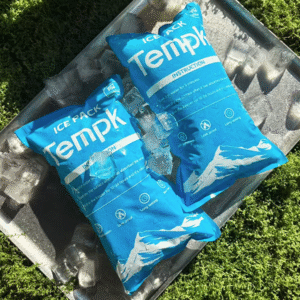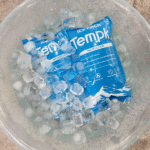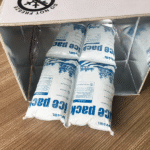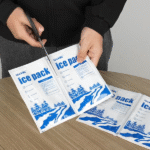Refrigerant Dry Ice Pack Sheet: How Do You Choose and Use It in 2025?
If you move temperature‑sensitive goods, a refrigerant dry ice pack sheet can stabilize lanes, extend hold time, and lower waste. You need the right temperature range, contar, and placement to hit your lane targets. En esta guía, you’ll learn how to size, embalar, and validate, so your parcel arrives within spec and without paying for excess weight.
-
Elegir refrigerant dry ice pack sheet that matches your lane and payload
-
Size sheet count with a fast estimator and examples for different durations
-
Pack out correctly to avoid hot spots and condensation in transit
-
Comparar refrigerant dry ice pack sheet vs gel packs, ladrillos, y hielo seco
-
Comply with labeling and safety expectations for sub‑zero shipments
What is a refrigerant dry ice pack sheet and why use it?
Respuesta directa:
A refrigerant dry ice pack sheet is a flexible grid of sealed cells filled with a phase‑change material (PCM) engineered to freeze below 0 °C and deliver cooling as it melts. It combines the “lay‑flat” coverage of a blanket with sub‑zero performance, helping you pre‑wrap product, line walls, or layer between items. Expect steadier gradients and fewer hot corners than loose packs when pack‑outs are consistent.
Explicación expandida:
Think of the sheet as a “cooling quilt” you pre‑condition like ice. The PCM holds a set freezing point, so it releases a steady stream of cold as it changes state. Many refrigerant dry ice pack sheet options target –5 °C to –20 °C ranges for pharma or frozen food. You can fold or cut along seams to fit boxes, which speeds lines and reduces labor. In parcel lanes with frequent hand‑offs, the uniform contact area limits thermal spikes caused by gaps that single gel bricks leave.
Refrigerant dry ice pack sheet vs gel packs: which performs better?
Detalles:
Gel packs are versatile but create point cooling and can slump. A refrigerant dry ice pack sheet spreads cold evenly and stays where you place it. If your lane sees door‑to‑door swings from 5 °C to 35 °C, sheets reduce risk of edge warming. For ultra‑cold or long export lanes, combine a refrigerant dry ice pack sheet layer with a small dry ice charge to extend hold time while controlling sublimation rates.
| Opción de enfriamiento | Rango típico | Acondicionamiento | Lo que significa para ti |
|---|---|---|---|
| paquetes de gel | 0–8 °C or –2–0 °C | 24–48 h at setpoint | Simple but uneven contact; may need more units to cover gaps |
| Refrigerant dry ice pack sheet | –5 to –20 °C targets | 24–48 h at target temp | Even blanket coverage; fold to fit; good for mixed SKUs |
| hielo seco (Co₂) | ~–78.5 °C surface | Not conditioned; handle with PPE | Long hold for frozen; hazmat labeling; risk of over‑freezing |
Consejos prácticos y sugerencias.
-
Last‑mile heat spikes: Wrap the payload top and sides with a refrigerant dry ice pack sheet to protect against sun‑heated lids.
-
Skus mixto: Use sheet segments between warm‑loading items to avoid self‑heating clusters.
-
Carriles de exportación: Pair one refrigerant dry ice pack sheet with a small dry ice block to flatten early‑trip over‑cooling.
Caso real: A regional meal kit added a refrigerant dry ice pack sheet over proteins and cut summer spoilage from 7% a 2% during a 72‑hour heatwave window.
How many refrigerant dry ice pack sheet units do you need?
Respuesta directa:
Start with a heat‑load estimate and the PCM’s latent heat. Multiply total watts of heat gain by your required hours, then divide by the sheet’s effective joules. For most insulated shippers, that gives a first pass within ±15%. Add 10–20% margin for hand‑offs and weekend holds.
Explicación expandida:
Your box gains heat from ambient temperature, seam leaks, y manejo. A refrigerant dry ice pack sheet contributes a predictable “cold battery” based on latent heat at its phase‑change point. If your lane spends time at 25–30 °C, you need more capacity than a mild spring route. Use the estimator below for quick sizing, then run a pack‑out test to verify.
Quick estimator for refrigerant dry ice pack sheet sizing
One‑box rule of thumb:
-
Box_U_value: overall heat transfer (W/m²·K) of your shipper
-
Surface_Area: exterior area (m²)
-
Δt: ambient minus target internal setpoint (K)
-
Sheet_Effective_Joules: latent + sensible energy per sheet at your range
| Example Scenario | Inputs | Resultado | What to Do |
|---|---|---|---|
| 12 L EPS shipper, ΔT=20 K, 48 H | U=0.6, A=0.9 m² | ~3–4 sheets | Comenzar con 4 refrigerant dry ice pack sheet units and validate |
| 18 L VIP shipper, ΔT=25 K, 72 H | U=0.18, A=1.1 m² | ~4–5 sheets | Empezar con 5 hojas; consider one layer top and bottom |
| 8 L EPS, ΔT=15 K, 24 H | U=0.7, A=0.7 m² | ~1–2 sheets | Try 2 hojas; remove 1 if product risks freezing |
Placement matters as much as sheet count
Detalles:
Put at least one refrigerant dry ice pack sheet por encima de la carga útil. Heat rises within the box when the top is sun‑heated, so top coverage prevents the “warm lid” effect. For tall payloads, add side sheets, or fold a long sheet into a U‑shape to hug the load. Para productos congelados, avoid direct contact with delicate produce; agregar una almohadilla corrugada.
Consejos prácticos
-
Skew top‑heavy: Usar 60% of total refrigerant dry ice pack sheet mass on top in summer lanes.
-
Layer gaps: Leave 3–5 mm air space above sensor data loggers.
-
Soft goods: Slip a kraft or foam pad between sheet and carton label to stop condensation bleed.
Caso real: A clinical site cut pack‑outs from 7 a 4 components after switching to a refrigerant dry ice pack sheet U‑wrap and maintained 48‑hour hold in 30 °C ambient.
How should you condition and pack a refrigerant dry ice pack sheet?
Respuesta directa:
Condition at the recommended setpoint until the cores are fully frozen. Mayoría refrigerant dry ice pack sheet models need 24–48 hours in a –10 °C to –20 °C freezer. Lay sheets flat, avoid stacking more than 5 alto, and verify core temperature before use.
Explicación expandida:
Under‑conditioned sheets deliver a short cold burst and then behave like heavy gel. Fully frozen, a refrigerant dry ice pack sheet gives hours of stable output near its phase‑change point. Use a probe thermometer or a touch‑safe IR gun to confirm. Label totes by time‑in/time‑out to keep FIFO discipline on the floor.
Step‑by‑step pack‑out with a refrigerant dry ice pack sheet
-
Pre -recorte la caja for 10–15 minutes if possible.
-
Place one refrigerant dry ice pack sheet at the bottom or skip if the product is freeze‑sensitive.
-
Add payload with spacers to create small air channels.
-
Drape a refrigerant dry ice pack sheet over the top; fold edges down.
-
Add side sheets for hot lanes or weekend risk.
-
Insert a data logger near the warmest corner.
-
Cerca, sello, y etiqueta.
| Pack‑Out Goal | Sheet Use | Sensitivity | Para ti |
|---|---|---|---|
| Congelado, 72 H | Abajo + arriba + lados | Bajo | Strong freeze protection with a refrigerant dry ice pack sheet envelope |
| Enfriar, 48 H | Top‑heavy, maybe sides | Medio | Avoid bottom sheet to prevent cold spots |
| Enfriar, 24 H | Single top sheet | Alto | Ligero, low‑cost pack‑out |
Do you need dry ice as well?
If your endpoint requires rock‑hard frozen at delivery, a small dry ice block can pair with a refrigerant dry ice pack sheet on the top layer. The sheet moderates early thermal shock; the dry ice extends tail hold. Keep CO₂ below the lid with vent holes and add appropriate labels.
Caso real: A bakery shipping croissants nationwide layered one refrigerant dry ice pack sheet over a 1 kg dry ice slab. They held texture and cut returns by half during holiday peaks.
How does a refrigerant dry ice pack sheet affect compliance and safety?
Respuesta directa:
Treat sub‑zero shipments with respect for freezing risk, condensación, and CO₂ handling when dry ice is present. A refrigerant dry ice pack sheet reduces free CO₂, but you still need gloves, protección para los ojos, and clear labels if you add dry ice.
Explicación expandida:
For healthcare, follow your quality system for packaging validation, monitoreo de temperatura, and lane qualification. Many teams run profiles like 0–8 °C for up to 72 hours or frozen profiles. A refrigerant dry ice pack sheet helps pass challenge segments by smoothing spikes, but documentation still matters. Para la comida, document that the core temperature stayed within safe limits across the lane and at delivery.
Safety checklist for refrigerant dry ice pack sheet shipments
-
PPE: Insulated gloves when handling frozen sheets or dry ice.
-
Ventilación: Nunca selle hielo seco en un recipiente hermético.
-
Etiqueta: Include “Frozen” or temperature range; add CO₂ identifiers if used.
-
Drop tests: Confirm seals hold; a refrigerant dry ice pack sheet should not burst if dropped.
| Riesgo | What to Watch | Mitigation | Beneficiarte para ti |
|---|---|---|---|
| Over‑freezing | Delicate produce, biológicos | Spacer pads, top‑only refrigerant dry ice pack sheet | Prevent texture and potency loss |
| Condensación | Humid lanes | Line with poly bag, absorbent pads | Protect labels and cartons |
| Acumulación de co₂ | Dry ice mix | Venting paths, etiquetas | Safety and compliance |
Costo y sostenibilidad: where does a refrigerant dry ice pack sheet fit?
Respuesta directa:
Total delivered cost improves when you cut spoilage, mano de obra, and DIM weight. A refrigerant dry ice pack sheet often replaces multiple gel bricks and reduces touches on fast pack lines.
Explicación expandida:
Sheets store flat when dry, boosting warehouse density. You can right‑size by cutting along seams, which avoids odd leftover bricks. If your customer supports take‑back, a refrigerant dry ice pack sheet can be re‑used after inspection, or recycled via specialized streams depending on the film.
Sustainability levers you control
-
Tamaño adecuado: Use only as many refrigerant dry ice pack sheet segments as needed.
-
Paquetes híbridos: Combine a sheet with lightweight VIP to slash coolant mass.
-
Re‑use programs: Inspect, desinfectar, and redeploy where allowed.
| Lever | Base | With Sheet | What You Gain |
|---|---|---|---|
| Coolant mass | 4 ladrillos de gel | 1 refrigerant dry ice pack sheet | Lower weight and freight |
| Pack‑out steps | 7–8 actions | 4–5 actions | Faster lines, menos errores |
| Storage volume | Loose bricks | Flat sheets | Better cube efficiency |
Caso real: An e‑grocery reduced coolant SKUs from 6 a 2 using a refrigerant dry ice pack sheet plus a standard gel. They saved three pallet positions per week.
Validación: how do you prove your refrigerant dry ice pack sheet works?
Respuesta directa:
Run an operational qualification (OQ) with your worst‑case payload and a summer profile, then run a performance qualification (PQ) on live lanes. Use a data logger inside the warm corner and near the top.
Explicación expandida:
Pre‑condition the refrigerant dry ice pack sheet at the recommended setpoint. Load your shipper to the lightest payload you expect, which heats fastest. Challenge with hot ambient. If the profile holds, heavier loads will be easier. For frozen lanes, confirm that sensitive SKUs do not over‑freeze.
Test design quick guide
-
Sensors: One in the warm corner, one near the top, one mid‑mass.
-
Profiles: 24/48/72 h holds with 25–35 °C ambient cycles.
-
Aceptación: Payload core within spec; no melted leaks.
| Test Step | Objetivo | Pass/Fail | Para ti |
|---|---|---|---|
| OQ hot profile | Worst case | Within temperature band | Confident launch |
| PQ pilot | Live parcels | Within delivery band | Real‑world proof |
| Post‑mortem | Root cause | Actionable tweaks | Faster iteration |
2025 trends for refrigerant dry ice pack sheet users
Descripción general de la tendencia:
En 2025, teams are moving to refrigerant dry ice pack sheet pack‑outs that integrate lane analytics and SKU‑specific inserts. Expect more flexible PCM blends that hold –10 °C to –15 °C without brittle films, plus lighter barrier films to reduce DIM. Data‑driven pack‑out rules are replacing tribal knowledge on the packing floor.
Últimos avances de un vistazo
-
Blended phase points: Tuned PCMs that keep a tighter –12 °C plateau for smoother curves.
-
Edge‑seal durability: New film seams tolerate repeated freeze‑thaw cycles, extending refrigerant dry ice pack sheet re‑use.
-
Digital SOPs: Mobile checklists that compute sheet count by lane and auto‑log conditioning time.
Ideas del mercado:
Kits de comida, muestras clínicas, and regional bakeries remain high adopters. The biggest gains come from replacing mixed coolant piles with a standardized refrigerant dry ice pack sheet kit. Expect procurement to push multi‑vendor compatibility, so choose dimensions and cut lines that fit common shippers.
Preguntas frecuentes
Q1: What temperature can a refrigerant dry ice pack sheet maintain?
Most hold a narrow sub‑zero window, often –5 °C to –20 °C. Pick the refrigerant dry ice pack sheet that matches your lane and validate with a logger.
Q2: How long does a refrigerant dry ice pack sheet last in transit?
Hold time depends on insulation, ambiente, and sheet count. Many lanes aim for 24–72 hours. Start with the estimator, then tune your refrigerant dry ice pack sheet contar.
Q3: Can I ship only with a refrigerant dry ice pack sheet for frozen?
Sí, for short lanes with strong insulation. For long export lanes, combine a refrigerant dry ice pack sheet with a small dry ice charge.
Q4: Will a refrigerant dry ice pack sheet over‑cool sensitive goods?
It can if placed under the product. Use top‑only placement or spacer pads with your refrigerant dry ice pack sheet.
Q5: How do I store and condition the sheets?
Lay flat, avoid tall stacks, and freeze for 24–48 hours at the target setpoint. Label totes and rotate refrigerant dry ice pack sheet stock FIFO.
Q6: How many sheets fit a small parcel box?
Many 8–12 L shippers fit one top refrigerant dry ice pack sheet or two folded sides. Validate before scaling.
Q7: Are refrigerant dry ice pack sheet materials recyclable?
Some films and PCMs are recyclable in specialized streams. Check local programs and your refrigerant dry ice pack sheet supplier’s guidance.
Q8: Do I need special labels?
Mark temperature range and contents. Si agrega hielo seco, include CO₂ identifiers. A refrigerant dry ice pack sheet alone is not hazardous.
Resumen y recomendaciones
Control de llave:
A refrigerant dry ice pack sheet spreads cold evenly, speeds packing, and reduces waste. Size by heat‑load, place one sheet on top, and add sides for hot lanes. Validate with a summer profile and data logging. Combine a refrigerant dry ice pack sheet with dry ice only when long frozen holds demand it.
Siguientes pasos (CTA):
-
Pick your target range and duration. 2) Use the quick estimator to select sheet count. 3) Run a one‑day OQ and adjust. 4) Roll out a SOP that standardizes your refrigerant dry ice pack sheet paquete. Talk to Tempk for a lane‑mapping session and a right‑sized starter kit.
Acerca de Tempk
We design and test cold chain packaging for food and healthcare. Nuestro refrigerant dry ice pack sheet options are engineered for consistent sub‑zero performance with cut‑to‑fit grids and robust edge seals. We validate against hot profiles and share clear conditioning SOPs. You get fewer touches, lower waste, and simpler audits.
Acción: Request a rapid lane assessment and a sample refrigerant dry ice pack sheet kit for your top two SKUs.
























